This set of Linear Integrated Circuit Multiple Choice Questions & Answers (MCQs) focuses on “Open Loop Op-Amp Configuration”.
1. Open loop op-amp configuration has
a) Direct network between output and input terminals
b) No connection between output and feedback network
c) No connection between input and feedback network
d) All of the mentioned
View Answer
Explanation: In an open loop configuration, the output signal is not fed back in any form as part of the input signal and the loop that would have been formed with feedback is open.
2. In which configuration does the op-amp function as a high gain amplifier?
a) Differential amplifier
b) Inverting amplifier
c) Non-inverting amplifier
d) All of the mentioned
View Answer
Explanation: An op-amp functions as a high gain amplifier when connected in open loop configuration. These three are the open loop configuration of an op-amp.
3. How does the open loop op-amp configuration classified?
a) Based on the output obtained
b) Based on the input applied
c) Based on the amplification
d) Based on the feedback network
View Answer
Explanation: Open loop configurations are classified according to the number of inputs used and the terminal to which the input is applied when a single input is used.
4. What will be the voltage drop across the source resistance of differential amplifier when connected in open loop configuration?
a) Zero
b) Infinity
c) One
d) Greater than one
View Answer
Explanation: The source resistances are normally negligible compared to the input resistance. Therefore, the voltage drop across input resistors can be assumed to be zero.
5. The output voltage of an open-loop differential amplifier is equal to
a) Double the difference between the two input voltages
b) Product of voltage gain and individual input voltages
c) Product of voltage gain and the difference between the two input voltages
d) Double the voltage gain and the difference between two input voltages
View Answer
Explanation: The output voltage is equal to the voltage gain times the difference between the two input voltages.
6. Calculate the output voltage for the given circuit.
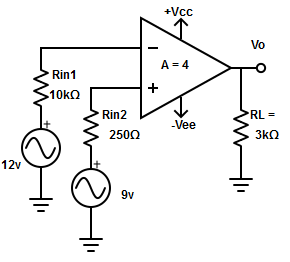
a) Vo = 7v
b) Vo = 5.9v
c) Vo = 12v
d) Vo = 11.4v
View Answer
Explanation: The output voltage, Vo = A*(Vin1-Vin2).(Since, Rin1 and Rin2 are negligible compared to input resistance in open loop differential amplifier).
=> Vo = 4*(12v-9v) = 12v.
7. Find the output of inverting amplifier?
a) Vo = AVin
b) Vo = -AVin
c) Vo = -A(Vin1– Vin2)
d) None of the mentioned
View Answer
Explanation: In an inverting amplifier the input signal is amplified by gain A and is also inverted at the output. The negative sign indicates that the output voltage is of opposite polarity.
8. Determine the output voltage for the non-inverting amplifier input voltage 37µVpp sinewave. Assume that the output is a 741.
a) -7.44 Vpp sinewave
b) 74 Vpp sinewave
c) 7.4Vpp sinewave
d) 0.7 Vpp sinewave
View Answer
Explanation: The output voltage for non-inverting amplifier Vo = A*Vin = 200000 * 37µ = 7.4 Vpp sinewave.
9. Find the non-inverting amplifier configuration from the given circuit diagram?
a)
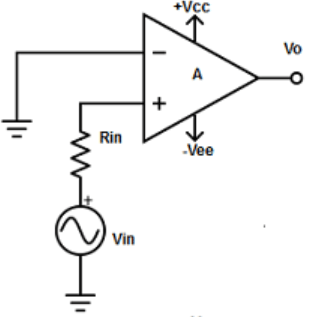
b)
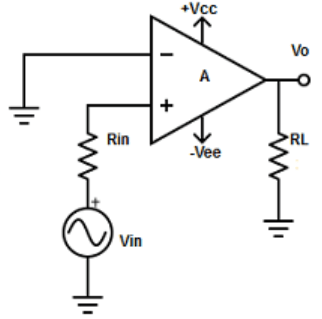
c)
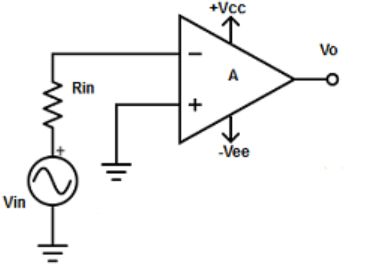
d)
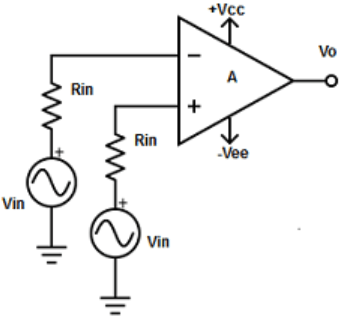
View Answer
Explanation: In a non-inverting amplifier, the input is applied to the non-inverting input terminal and the inverting terminal is connected to ground.
10. What happen if any positive input signal is applied to open-loop configuration?
a) Output reaches saturation level
b) Output voltage swing’s peak to peak
c) Output will be a sine waveform
d) Output will be a non-sinusoidal waveform
View Answer
Explanation: In open-loop configuration, due to very high gain of the op-amp, any input signal slightly greater than zero drives the output to saturation level.
11. Why open-loop op-amp configurations are not used in linear applications?
a) Output reaches positive saturation
b) Output reaches negative saturation
c) Output switches between positive and negative saturation
d) Output reaches both positive and negative saturation
View Answer
Explanation: When operated in open loop, the output switches between positive and negative saturation levels. For this reason, open loop op-amp configurations are not used in linear applications.
Sanfoundry Global Education & Learning Series – Linear Integrated Circuits.
To practice all areas of Linear Integrated Circuits, here is complete set of 1000+ Multiple Choice Questions and Answers.
If you find a mistake in question / option / answer, kindly take a screenshot and email to [email protected]
- Practice Electrical Engineering MCQs
- Practice Electronics & Communication Engineering MCQs
- Apply for Electrical Engineering Internship
- Apply for Electronics & Communication Engineering Internship
- Check Linear Integrated Circuits Books
